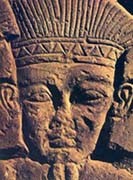The Philistines

The Philistines have a three-millennia-old reputation for being a society of warlike pagans, devoid of aesthetic or intellectual values. What does the archaeological evidence say? BAS editors have arranged a special collection of articles on the Philistines exploring their origins, cities, Biblical ailments and even their status as modern fashion icons.
Scroll down to read a summary of these articles.
What We Know About the Philistines
BAR, Jul/Aug 1982
by Trude Dothan
When Canaanites and Philistines Ruled Ashkelon
BAR, Mar/Apr 1991
by Lawrence E. Stager
One if by Sea...Two if by Land: How Did the Philistines Get to Canaan?: How Did the Philistines Get to Canaan? One: by Sea
BAR, Mar/Apr 2003
by Tristan Barako
One if by Sea...Two if by Land: How Did the Philistines Get to Canaan?: How Did the Philistines Get to Canaan? Two: by Land
BAR, Mar/Apr 2003
by Assaf Yassar-Landau
Excavating Ekron
BAR, Nov/Dec 2005
by Seymour Gitin
The Philistines and the Dothans: An Archaeological Romance, Part 2
BAR, Sep/Oct 1993
by Hershel Shanks
Excavating Philistine Gath: Have We Found Goliath’s Hometown?
BAR, Nov/Dec 2001
by Carl S. Ehrlich, Aren M. Maeir
Did Captured Ark Afflict Philistines with E.D.?
BAR, May/June 2008
by Aren M. Maeir
Philistine Fashion
BAR, Nov/Dec 2003
by Trude Dothan
In the 1982 exposé “What We Know About the Philistines,” Trude Dothan reveals a stunning artistic repertoire that made the Philistine material culture shine above that of its Canaanite peers. The timeless study includes the discussions “Philistines in the Patriarchal Age,” “Did the Philistines Write?” and “Philistines after David.”
In “When Canaanites and Philistines Ruled Ashkelon,” Lawrence E. Stager marshals an impressive array of evidence from the 5,500-year-old city—ranging from lowly loomweights to Homeric epics—to answer the longstanding question of where the Sea Peoples came from. The answer belies the dictionary definition of “philistine.”
How did the Sea Peoples migrate from their Aegean homeland to the Eastern Mediterranean? In the lively discussion “How did the Philistines get to Canaan?” Tristan Barako presents “One: by Sea” while Assaf Yasur-Landau counters with “Two: by Land.”
What happened to the Philistines after the rise of the Israelites—Did they disappear after 1000 B.C.? In “Excavating Ekron,” Seymour Gitin disagrees with this widely held view, stating that the major Philistine city survived by absorbing other cultures.
Husband and wife Moshe and Trude Dothan worked so extensively with Philistine sites that BAR labeled them “Mr. and Mrs. Philistine.” In the second part of “The Philistines and the Dothans: An Archaeological Romance,” the couple describes the sites, legacy, history and chronology of the Philistines and Sea Peoples.
Archaeologists have long known the location of four of the five cities of the Philistine Pentapolis, but Gath, the home of Goliath, had eluded identification until recently. In “Excavating Philistine Gath,” Aren M. Maeir and Carl S. Ehrlich identify the site of Tell es-Safi as ancient Gath.
What was the embarrassing ailment that caused The Philistines to return the Ark of the Covenant to the Israelites? For centuries, the painful affliction has been translated as “hemorrhoids,” but Aren M. Maeir argues that the Philistines were protecting their manhood in “Did Captured Ark Afflict Philistines with E.D.?”
This Philistines were not just enemies of the Israelites; they are also unwitting icons of style. In “Philistine Fashion,” Trude Dothan takes a look at two beautifully crafted objects that proved to be an unusual designer accessory.
